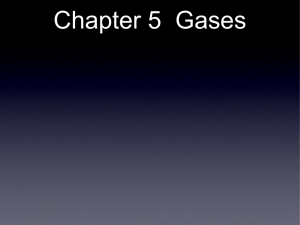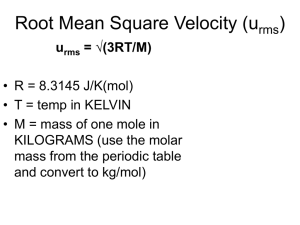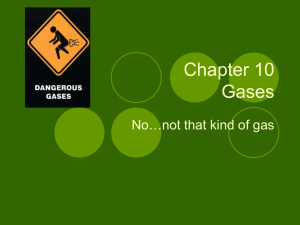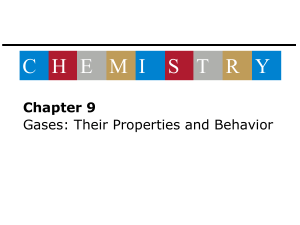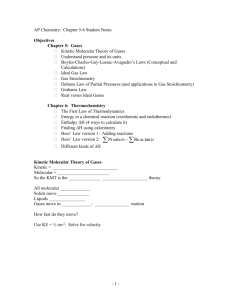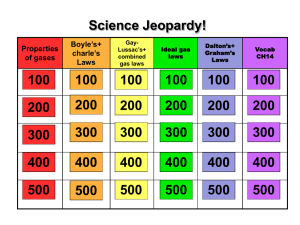Chapter 11 Gas Laws
advertisement
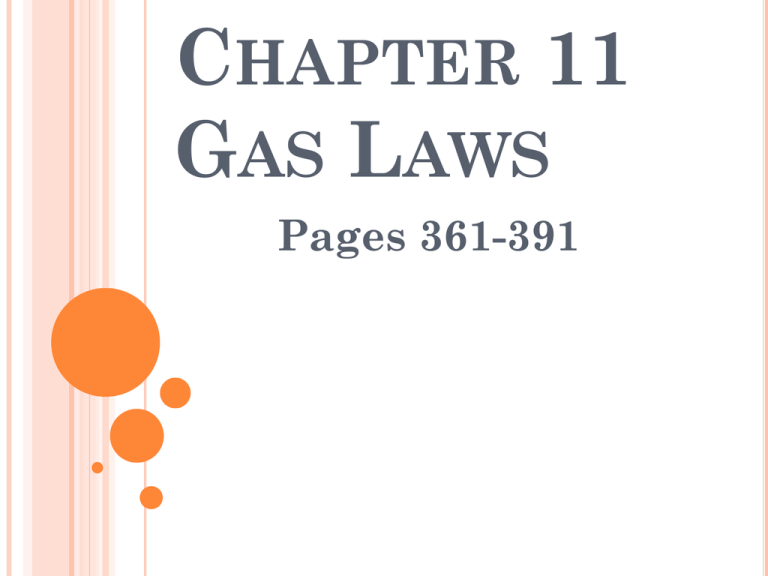
CHAPTER 11 GAS LAWS Pages 361-391 7 Stamps 7 warm ups! BACKGROUND INFORMATION Air is composed of several kinds of colorless gases. Some gases have color. Chlorine (Cl2): yellow green Nitrogen Dioxide (NO2): brownish-red Any 1 mole of a gas occupies a volume of 22.4 L. KINETIC MOLECULAR THEORY OF GASES Ideal Gas: A hypothetical gas that perfectly fits all assumptions of the kinetic-molecular model. Real gas: A gas that does not behave according to the assumptions of the kineticmolecular theory. KINETIC MOLECULAR THEORY OF GASES 1. Gas Consists of large numbers of tiny particles that are far apart relative to their size. 2. Collisions between gases are always elastic. An elastic collision is one where there is no net loss of total kinetic energy. 3. Gas particles are in continuous, rapid, random motion. 4. There are no forces of attraction between gas particles. 5. The temperature of a gas depends on the average kinetic energy of the particles. GASES AND PRESSURE Pressure: Force per unit area on a surface Equation= FORCE AREA Pressure= area Pressure= area GASES AND PRESSURE GASES AND PRESSURE Different units for measuring pressure: (need to memorize!) 1 atm 760 mmHg 101.3 kPa 101300 Pa 760 torr 14.7 lb/in2 CONVERTING PRESSURE 745mmHg=_________________Kpa 16.5atm= __________________lb/in2 11.3 lb/in2=_________________Kpa 100.7Kpa=__________________atm Barometer: Instrument used to measure pressure. TEMPERATURE CONVERSIONS Temperature: Kelvin system: K=°C+273 -16°C=__________K 8.7°C=___________K 212K=__________°C 0K=_____________°C Standard Temperature and Pressure (STP): Temperature: 273 K Pressure: 1 atm 760 mmHg 101.3 kPa 101300 Pa 760 torr 14.7 lb/in2 DALTON’S LAW OF PARTIAL PRESSURE The sum of the partial pressures of all the components in a gas mixture is equal to the total pressure of a gas mixture. Equation: P1 + P2 + P3 + ……. = PTotal DALTON’S LAW OF PARTIAL PRESSURE EXAMPLES A person using an oxygen mask is breathing air with 33% oxygen. What is the partial pressure of oxygen with the air pressure in the mask is 110Kpa? DALTON’S LAW OF PARTIAL PRESSURE EXAMPLES What is the atmospheric pressure if the partial pressure of nitrogen, oxygen and argon are 604.5mmHg, 162.8mHg, and 0.5mmHg, respectively? DALTON’S LAW OF PARTIAL PRESSURE EXAMPLES • Oxygen gas from the decomposition of potassium chlorate was collected by water displacement. The barometric pressure and the temperature during the experiment were 731.0 torr and 20.0C. What was the partial pressure of the oxygen collected? (Hint: Use Table A-8 in your text!) PRESSURE AND VOLUME: BOYLE’S LAW The volume of a gas is indirectly proportional to the Pressure (@ S.T) Equation: Visually: P1V1 = P2V2 PRESSURE AND VOLUME: BOYLE’S LAW EXAMPLES A gas has an initial volume of 242cm3 at a pressure of 87.6Kpa, what is the volume if the pressure changes to standard pressure? PRESSURE AND VOLUME: BOYLE’S LAW EXAMPLES A gas at a pressure of 608mmHg is held in a container with a volume of 545cm3. The volume of the container is then increased to 1065cm3 without a change in temperature. Calculate the new pressure of the gas VOLUME AND TEMPERATURE: CHARLES’ LAW The volume of a gas is directly proportional to the temperature (@ S.P). Equation: V1 = V2 T1 T2 Visually: VOLUME AND TEMPERATURE: CHARLES’ LAW Animations http://www.marymount.k12.ny.us/marynet/06stw bwrk/06gas/1esepcharles/esepcharles.html http://www.marymount.k12.ny.us/marynet/06stw bwrk/06gas/2slyscharles/2slysflash.html VOLUME AND TEMPERATURE: CHARLES’ LAW - EXAMPLES • If 20.0L of Oxygen gas are cooled from 100C to 0C. what is the new volume? VOLUME AND TEMPERATURE: CHARLES’ LAW - EXAMPLES • A gas can be used as a thermometer. IF it is known that the sample of gas has a volume of 1.00L at 255K, what is the temperature if the volume of the same gas sample is changed to 0.45L PRESSURE AND TEMPERATURE: GAYLUSSAC’S LAW The pressure of a gas is directly proportional to the temperature (@ constant volume). Equation: PRESSURE AND TEMPERATURE: GAYLUSSAC’S LAW - EXAMPLES • The gas in a container is at a pressure of 3.00 atm at 25ºC. Directions on the container warn the used not to keep it in a place where the temperature exceeds 52ºC. What would the gas pressure in the container be at a 52ºC? PRESSURE AND TEMPERATURE: GAYLUSSAC’S LAW - EXAMPLES • At 120.0ºC the pressure of a sample of nitrogen is 1.07 atm. What will the pressure be at 205ºC, assuming constant volume? COMBINED GAS LAW Incorporates both Boyle’s and Charles’ laws. It relates pressure, volume and temperature. Equation: P1V1 = P2V2 T1 T2 COMBINED GAS LAW EXAMPLES A gas has a volume of 10.0cm3 measured at 75.6Kpa and 60.0C, what is the new volume if conditions change to STP? COMBINED GAS LAW EXAMPLES A gas that had a volume of 955cm3 measured at 58C and 108.0Kpa, what will be the new volume if the conditions change to 76.0C and 123.0Kpa? GAY-LUSSAC’S LAW OF COMBINING VOLUMES OF GASES at constant _______________ and _________________, the _______________ of gaseous reactants and producs can be expressed as _____________ of _________________ _____________ ________________. Animation http://www.marymount.k12.ny.us/marynet/06stw bwrk/06gas/1amcslussac/amcsgaylussac.html VOLUME AND MOLES: AVAGADRO’S LAW The volume of a gas is _____________proportional to the number of moles of that gas (@ S.T). Equation: An anmimation: http://www.marymount.k12.ny.us/marynet/06stw bwrk/06gas/2lpimavogdro/2lpimavogadro.html VOLUME AND MOLES: AVAGADRO’S LAW EXAMPLES Suppose we have a 12.2 L sample containing 0.50 moles of oxygen gas at a pressure of 1 atm and a temperature of 25 C. If all of this oxygen is converted to ozone, O3, at the same temperature and pressure, what will be the volume of ozone formed? VOLUME AND MOLES: AVAGADRO’S LAW EXAMPLES • Consider two samples of nitrogen gas. Sample one contains 1.5 moles of nitrogen and has a volume of 36.7 L at 25 C and 1 atm. Sample 2 has a volume of 16.5 L at 25 C and 1 atm. Calculate the number of moles of nitrogen in sample 2. GAS STOICHIOMETRY: Standard molar volume of a gas: The volume occupied by ____________ ___________ of a gas at STP has been found to equal ______________________. Example: What volume does 0.0685 mol of gas occupy at STP? GAS STOICHIOMETRY: EXAMPLE Propane, C3H8, is a gas that is sometimes used as a fuel for cooking and heating. It undergoes a combustion reaction. What will be the volume of oxygen required for the complete combustion of 0.350L of propane? THE IDEAL GAS LAW PV=nRT Where P= V= n= R= T= THE IDEAL GAS LAW EXAMPLES • What pressure will be exerted by .622 mol of a gas contained in 9.22L at 16C. Find pressure in Kpa. THE IDEAL GAS LAW EXAMPLES • How many moles of a gas will occupy a 486cm3 flask at 10.C and 66.7 Kpa? THE IDEAL GAS LAW EXAMPLES What volume will be occupied by .684mol of gas at 99.4Kpa and 9C? DIFFUSION AND EFFUSION Diffusion: Effusion: Animation: http://www.marymount.k12.ny.us/marynet/06stw bwrk/06gas/2hdkrdiffusion/2hdkrdiffusion.html DIFFUSION AND EFFUSION Graham’s Law: Rates of _________________ of gases at the same _____________ and ______________ are inversely proportional to the _______________ ____________ of their ________________ ________________. DIFFUSION AND EFFUSION EXAMPLES Compare the rates of effusion of hydrogen and oxygen at the same temperature and pressure. DIFFUSION AND EFFUSION EXAMPLES Compare the rate of effusion of carbon dioxide with that of hydrogen chloride at the same temperature and pressure. Animation Summary: http://www.mhhe.com/physsci/chemistry/essentia lchemistry/flash/gasesv6.swf Web Quest http://www.chemheritage.org/EducationalService s/webquest/blimp.htm

